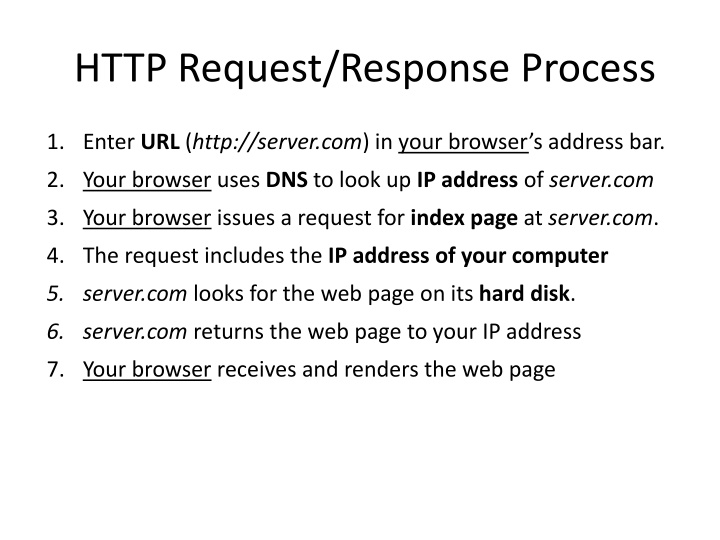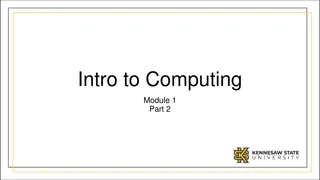
Web Page Structure and Processing
Discover the detailed process of HTTP requests and responses, PHP and MySQL interactions, layers of a web page, and the difference between layers and tiers in web development. Learn about DNS, server operations, and the roles of HTML, CSS, and JavaScript in website creation. Explore the functionality of databases like MySQL and the three tiers of a web application.
Download Presentation

Please find below an Image/Link to download the presentation.
The content on the website is provided AS IS for your information and personal use only. It may not be sold, licensed, or shared on other websites without obtaining consent from the author. If you encounter any issues during the download, it is possible that the publisher has removed the file from their server.
You are allowed to download the files provided on this website for personal or commercial use, subject to the condition that they are used lawfully. All files are the property of their respective owners.
The content on the website is provided AS IS for your information and personal use only. It may not be sold, licensed, or shared on other websites without obtaining consent from the author.
E N D
Presentation Transcript
HTTP Request/Response Process 1. Enter URL (http://server.com) in your browser s address bar. 2. Your browser uses DNS to look up IP address of server.com 3. Your browser issues a request for index page at server.com. 4. The request includes the IP address of your computer 5. server.com looks for the web page on its hard disk. 6. server.com returns the web page to your IP address 7. Your browser receives and renders the web page
time Client Chrome Web Browser Server Apache Web Server Request with URL and client IP Response with HTML document Request with URL and client IP Response with HTML document
HTTP Procedure with PHP & MySQL 1. Enter URL (http://server.com) in your browser s address bar. 2. Your browser uses DNS to look up IP address of server.com 3. Your browser issues a request for index page at server.com. 4. The request includes the IP address of your computer 5. server.com looks for the web page on its hard disk. 6. server.com notices that the web page has PHP code. 7. server.com invokes PHP interpreter to execute the PHP code. 8. PHP interpreter executes MySQL connect function and query 9. MySQL database returns query results 10. PHP interpreter uses result to generate/output web page 11. server.com returns the web page to your IP address 12. Your browser receives and renders the web page
Database MySQL DBMS Server Server Apache Web Server Client Chrome Web Browser Request with URL and client IP URL is a PHP program PHP program connects to MySQL Query results are sent PHP program receives results processes them and generates HTML document Response with HTML document
3 Layers of a web page Content (not really a layer) The text, images, audio, and video 1. Structural Layer HTML elements used to markup content 2. Presentational Layer CSS codeto decorate the HTML elements 3. Behavioral Layer JavaScriptcode that can dynamically change anything on the page
Confusion: 3 Layers vs. 3 Tiers Web Page has 3 Layers HTML Content, structure, semantics CSS Styles, presentation, layout JavaScript Interaction, behavior, client-side processing Web Application are implemented with 3 Tiers Client Web browser, user device, chrome Server Web server, server-side processing, PHP Database DBMS, tables that store content, MySQL
Tiers of a web application 1. Client Tier web browser or HTML rendering engine Sometimes rendering engines are built into other applications. Responsible for displaying a web page HTMLand CSSrendering JavaScriptinterpreter Examples: Chrome, Firefox, Safari, Internet Explorer, Opera, web viewer built into Facebook mobile app.
Tiers of a web application 2. Server Tier The web server, daemon software Responsible for responding to HTTP requests and server- side processing Examples: Apache, Microsoft IIS, nginx, Google s GWS, Java System Web Server, Node JS Server-side scripting languages: PHP, ASP, JSP, ColdFusion, Ruby, Perl, Python, etc.
Tiers of a web application 3. Database Tier Database server Responsible for storing and managing raw content Examples: MySQL, Microsoft s SQL Server, Oracle 8i or rDB, IBM s DB2, PostgreSQL, SQLite, etc.
HTML HyperText Markup Language A simple text document can be marked-up with tags to specify how it should be interpreted. <h1>Level 1 Header</h1> <p>This is a paragraph </p>
Semantics HTML is supposed to be a structural or semantic language, Browser Wars led to the introduction of style or formatting tags. Formatting tags have been removed from the HTML standards (called deprecation).
CSS Cascading Style Sheets Used to specify the style/appearance of structural elements (HTML tags). CSS was part of the original design of the web, but it was not widely used during the browser wars.
CSS p { text-indent: 16px; font-weight: bold; } table { border: 1px solid black; }
JavaScript nothing to do with Java programming languages 1994 Developed by Netscape called Mocha, LiveScript, and then JavaScript 1995 Microsoft developed Jscript for IE 1996 Standard language called ECMAScript was proposed and eventually adopted by W3C 1999 Most major web browsers followed the ECMA standard, but the name JavaScript stuck.
About JavaScript JavaScript has become a mature application development language. A powerful web server called node.js is implemented with JavaScript and uses it for server-side application scripting. Google s Chrome browser uses JavaScript to implement many of its UI features. Some recent surveys indicate that JavaScript is the #1 language employers look for on resumes
HTML & Javascript <!DOCTYPE html> <html> <head> <script> function displayDate() { document.getElementById("demo").innerHTML=Date(); } </script> </head> <body> <h1>My First JavaScript</h1> <p id="demo">This is a paragraph.</p> <button type="button" onclick="displayDate()">Display Date</button> </body> </html>
PHP A somewhat popular server-side scripting language http://php.net Comes with Apache (popular free web server software) Example:http://www.w3schools.com/php/showphp.asp?file name=demo_loop_for PHP stands for PHP Hypertext Pre-processor, where The PHP stands for PHP Hypertext Pre-processor, where The PHP stands for PHP Hypertext Pre-processor, where The PHP stands for PHP Hypertext Pre-processor, where
MySQL An almost-free database management system that integrates nicely with an Apache PHP-enabled web server. Used to be 100% free open source Bought by Oracle (damn!) GNU Public license version which is still free Does not scale up for really huge applications











